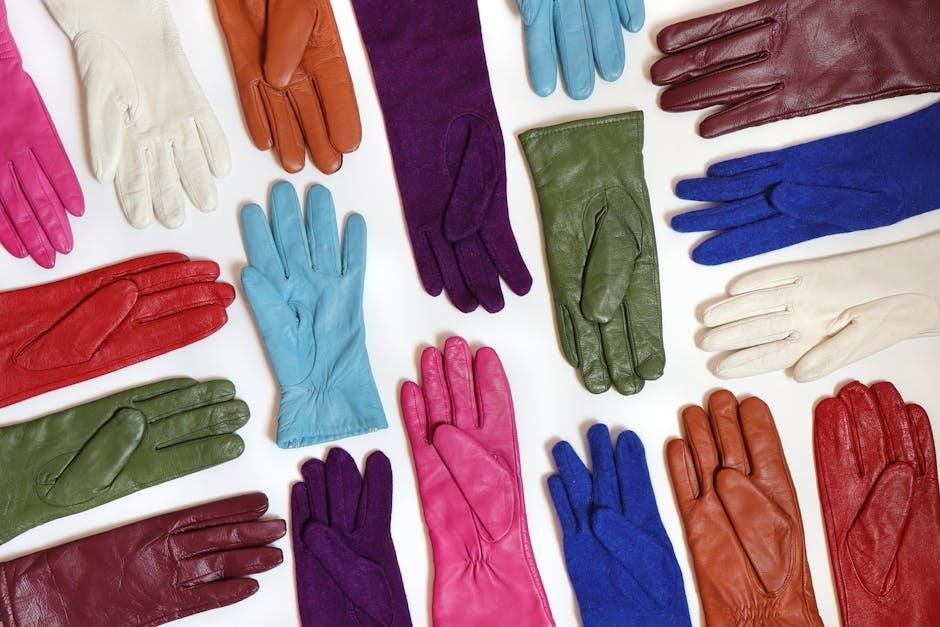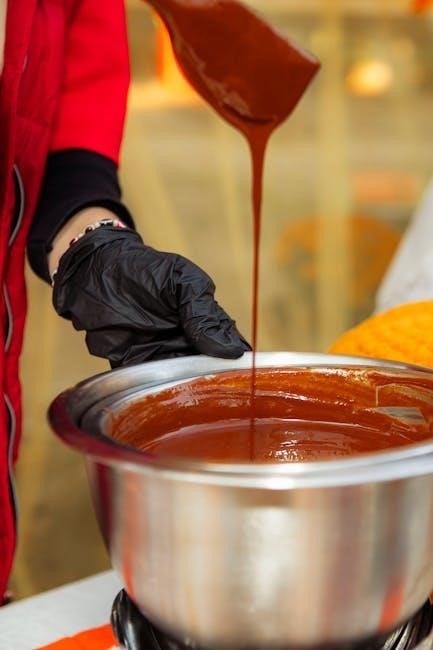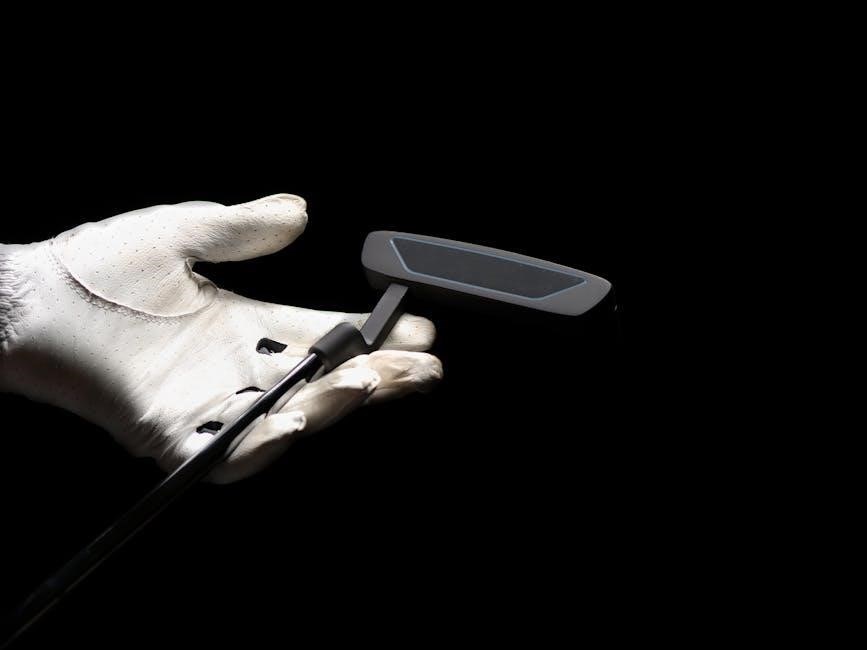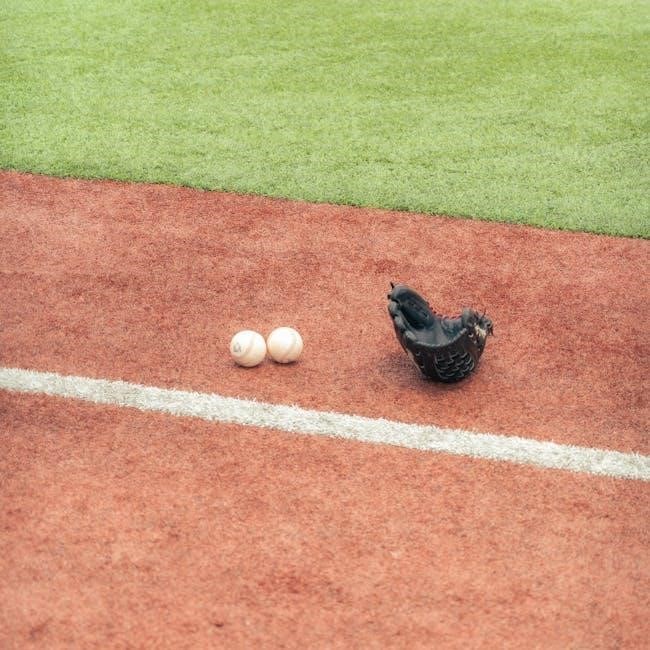Selecting the right softball glove size is crucial for performance and comfort. Proper sizing varies by position, age, and hand size, ensuring a secure, functional fit.
Why Glove Size Matters
Glove size is essential for optimal performance and comfort in softball. A properly sized glove ensures a secure fit, allowing for better control and precision when catching and throwing. If a glove is too small, it may restrict movement and cause discomfort, while an oversized glove can hinder dexterity and responsiveness. Proper sizing also affects the ability to handle the ball effectively, as different positions require specific pocket depths and designs. For infielders, a smaller, shallower glove enables quick transfers, whereas outfielders benefit from larger, deeper pockets to catch fly balls. Incorrect sizing can lead to errors and potential injuries, making it crucial to choose a glove tailored to your position, hand size, and playing style.
Overview of the Guide
This guide provides a comprehensive approach to selecting the ideal softball glove, focusing on key factors such as measurements, position-specific recommendations, and proper fitting techniques. It outlines the importance of understanding glove sizing, including how sizes are determined and the impact of materials and web types on fit. The guide also offers detailed suggestions for different age groups, from youth to adult players, ensuring that each player can find a glove that meets their needs. By following the tips and recommendations provided, players can enhance their performance, improve comfort, and make informed decisions when choosing the right softball glove for their game.

Understanding Softball Glove Measurements
Softball gloves are measured from the tip of the index finger to the wrist, typically ranging from 8 to 15 inches. Proper measurements ensure optimal fit and performance.
How Glove Sizes Are Determined
Glove sizes are determined by measuring the distance from the tip of the index finger to the base of the wrist. This measurement typically ranges from 8 to 15 inches. Position, age, and hand size are key factors. Infielders prefer smaller gloves (11-11.5 inches) for quicker transfers, while outfielders opt for larger sizes (12-12.75 inches) to handle longer throws. Pitchers often choose smaller gloves for better control. Youth players usually require smaller sizes (9-11.5 inches), while high school and adult players use larger gloves (11-14 inches). Proper fit ensures comfort and performance, so measuring hand size and trying on gloves is essential for the right fit.
Key Factors Influencing Glove Size
Position, age, and hand size are the primary factors influencing softball glove size; Infielders need smaller gloves for quick ball transfers, while outfielders prefer larger sizes for catching long throws. Pitchers often opt for smaller gloves to conceal the ball. Youth players require smaller sizes to develop proper fielding habits, while adults need larger gloves for better control. Hand size and finger length also play a role, as a snug fit ensures optimal performance. Additionally, the type of softball—fastpitch or slowpitch—affects glove size, with fastpitch players typically using smaller gloves. Ensuring the right fit enhances both comfort and gameplay efficiency, making it essential to consider these factors when choosing a glove.

Suggested Glove Sizes by Position
Infielders typically use 11-11.5 inch gloves, outfielders prefer 12-12.75 inches, pitchers opt for 11-12 inches, and first basemen use larger mitts, around 12-13 inches.
Infield Gloves: Size Recommendations
Infield gloves are designed to be smaller and more agile, typically ranging from 11 to 11.5 inches. This size allows infielders to quickly transfer the ball to their throwing hand. The shallow pocket design helps with rapid exchanges, making it ideal for fielding ground balls and line drives. For younger players, sizes can start as small as 9 inches, gradually increasing as they grow. Proper fit ensures control and responsiveness, crucial for infield positions like second base, shortstop, and third base. When selecting an infield glove, prioritize a snug yet comfortable fit to enhance fielding precision and speed.
Outfield Gloves: Size Recommendations
Outfield gloves are larger and deeper than infield gloves, typically ranging from 12 to 12.75 inches. This larger size allows outfielders to catch fly balls more effectively. The deeper pocket helps secure the ball on long throws and high catches. For younger players, sizes start around 10 inches, increasing as they develop. The glove’s size and weight should balance comfort and functionality, ensuring outfielders can cover the vast field space efficiently. Proper fit is essential to maintain control and accuracy when tracking and catching fly balls, making it a vital tool for outfield positions.
Pitcher’s Gloves: Size Recommendations
Pitcher’s gloves are typically smaller, ranging from 11 to 12.5 inches, allowing for quick ball control and precise throws. A closed web design is often preferred, as it conceals the ball during pitches and provides additional support. The snug fit helps pitchers grip and release the ball effectively. Youth pitchers may opt for slightly smaller sizes, around 10-11 inches, ensuring ease of movement. Proper sizing is critical for pitchers, as it directly impacts their ability to handle the ball and execute plays efficiently during games. A well-fitted glove enhances performance and confidence on the mound.
First Baseman’s Gloves: Size Recommendations
First basemen typically use larger gloves, often referred to as mitts, with sizes ranging from 12 to 12.75 inches. These gloves feature a deep pocket and a single-piece web, designed to scoop and secure throws from infielders. The larger size and deeper pocket help first basemen handle high throws and pick balls out of the dirt more effectively. A snug fit is essential to maintain control and responsiveness. For youth players, sizes may be slightly smaller, around 11.5 to 12 inches, to accommodate smaller hands while still providing the necessary functionality. Proper sizing ensures better performance and confidence at first base.

Glove Sizing by Age Group
Glove size varies by age to ensure proper fit and performance. Youth players typically use smaller gloves, while high school, college, and adult players require larger sizes.
Youth Players: Recommended Sizes
Youth softball players typically use gloves ranging from 9 to 11.5 inches, depending on their age and hand size. For players under 8, a 9-10 inch glove is ideal, while those aged 10-14 often prefer 10-12 inch sizes. These smaller gloves help young players develop proper throwing and catching techniques. A smaller glove allows better control and quicker responses, which are essential for skill development. Parents should ensure the glove fits snugly but not too tightly, as this can hinder movement. Avoid oversized gloves, as they may lead to poor fielding habits. Choosing the right size early on helps build confidence and improves performance in young athletes.
High School and College Players: Recommended Sizes
High school and college softball players typically use gloves ranging from 11.5 to 13 inches, depending on their position and preference. For infielders, an 11.5 to 12.5-inch glove is ideal, providing quick transfers and control. Outfielders often prefer larger gloves, around 12 to 13 inches, to handle longer throws and deeper pockets. Pitchers may opt for slightly smaller sizes, around 11.5 to 12 inches, for better feel and dexterity. The larger sizes accommodate the bigger softball and the advanced skill level of these players. Proper fit is crucial for performance, as it ensures comfort and durability during competitive play. Players should try on multiple models to find the best fit for their hand and position.
Adult Players: Recommended Sizes
Adult softball players typically use gloves ranging from 12 to 14.5 inches, depending on their position and preference. Outfielders often prefer larger gloves, around 13 to 14.5 inches, to handle deeper pockets and longer throws. Infielders and pitchers may opt for slightly smaller sizes, around 12 to 13 inches, for quicker transfers and better control. The larger sizes accommodate the adult player’s hand size and the demands of competitive play. Proper fit is essential for comfort and performance, as ill-fitting gloves can hinder dexterity and durability. Adults should consider their hand size and position-specific needs when selecting a glove, ensuring it feels snug yet allows for natural movement. Trying on multiple models is recommended to find the ideal fit.

How to Measure Your Hand for a Glove
Measure from the tip of your index finger to the base of your wrist while flexing your hand slightly. This ensures a snug, functional fit for optimal performance.
Step-by-Step Measurement Guide
To ensure the perfect fit, measure your hand accurately. Lay your hand flat with fingers together. Measure from the tip of your index finger to the base of your wrist. Include the palm but exclude the wrist. This length determines your ideal glove size. For youth players, sizes range from 9 to 11.5 inches, while adults typically prefer 11 to 13 inches. Always consider your position and personal comfort. Try on several models to find the best fit, ensuring flexibility and control.

How to Read Glove Sizes
Softball glove sizes are typically marked on the thumb or pinky finger, ranging from 8 to 15 inches for fielders’ gloves, ensuring a proper fit and optimal performance.
Understanding Glove Size Markings
Glove sizes are usually engraved on the thumb or pinky, indicating the glove’s length in inches. Measurements range from 8 to 15 inches for fielders. These markings help determine if the glove fits your hand properly. Proper sizing is essential for performance and comfort, allowing for precise control during plays. By understanding these markings, players can choose a glove that suits their position and hand size effectively, ensuring optimal functionality and support during games.

Softball vs. Baseball Gloves: Size Differences
Softball gloves are larger than baseball gloves due to the bigger ball size. Softball infield gloves range from 11.5 to 12.5 inches, while baseball gloves are 11.25 to 12 inches.
Key Differences in Sizing
Softball gloves are generally larger than baseball gloves due to the bigger size of the softball. Typically, softball gloves range from 11.5 to 13 inches, while baseball gloves are smaller, ranging from 11.25 to 12 inches. This difference accommodates the larger circumference of the softball, ensuring a secure catch and control. Additionally, softball gloves often feature deeper pockets and slightly longer fingers to handle the bigger ball. While the size difference may seem minimal, it significantly impacts performance, making it essential for players to choose gloves designed for their specific sport. Proper sizing ensures better grip, accuracy, and overall gameplay efficiency.
Why Size Matters for Different Sports
Glove size is critical for optimal performance in both softball and baseball, as each sport demands specific requirements. Softball gloves are designed to accommodate the larger ball, ensuring secure catches and throws, while baseball gloves prioritize precision and agility for smaller balls. Using a glove intended for the wrong sport can lead to poor performance, as it may not fit the ball or the player’s hand properly. Proper sizing ensures better control, accuracy, and comfort, making it essential to choose a glove tailored to the sport being played. The right fit enhances overall gameplay, preventing errors and discomfort during critical moments on the field.

Materials and Their Impact on Glove Fit
Leather gloves offer durability and a snug fit, molding to your hand over time, while synthetic materials provide lightweight comfort and easier break-in, catering to different preferences.
Leather vs. Synthetic Materials
Leather gloves are preferred for their durability and ability to mold to the player’s hand over time, providing a snug, customized fit. Synthetic gloves, while lighter and easier to break in, may lack the longevity and feel of leather. The choice between materials often depends on personal preference, playing style, and budget. Leather offers a traditional, premium experience, whereas synthetic options are more affordable and require less maintenance. Both materials can deliver excellent performance, but understanding their differences helps players choose the best fit for their needs and level of play.
Glove Web Types and Their Effect on Fit
Glove web types significantly impact fit, with styles like closed, open, and modified webs offering varying levels of support and flexibility to suit different playing styles.
Popular Web Styles for Softball
Softball gloves feature various web styles, each designed for specific positions and preferences. The most common include the closed web, open web, and modified web. A closed web provides stability and is ideal for pitchers, as it conceals the ball. Open webs offer better flexibility and are often preferred by infielders for quicker ball transfers. Modified webs combine elements of both, offering a balance of support and flexibility. Each style impacts how the glove performs, with variations in pocket depth and finger movement. Players should choose a web type that aligns with their position and playing style to optimize control and performance on the field.

Pocket Depth and Its Importance
Pocket depth significantly impacts a softball glove’s performance, affecting ball control and retrieval. Deeper pockets enhance grip, while shallower ones enable quicker transfers, crucial for infielders.
How Pocket Depth Affects Performance
Pocket depth significantly influences a player’s ability to control and transfer the ball. A shallower pocket allows infielders to quickly retrieve and throw the ball, minimizing delays. Deeper pockets, often preferred by outfielders, provide a more secure grip during longer throws. The depth must align with the player’s position and style to ensure optimal performance. Proper pocket depth enhances accuracy and confidence, making it a critical factor in glove selection.
- Shallow pockets suit infielders for faster transfers.
- Deeper pockets benefit outfielders for secure catches.
Matching pocket depth to position ensures better control and efficiency in gameplay.
How to Try On a Softball Glove
Ensure a snug, secure fit without restricting movement. The glove should feel comfortable and allow easy closing. Proper fit enhances performance and control during gameplay.
Tips for Ensuring the Right Fit
To ensure the right fit for your softball glove, consider these essential tips: measure your hand from the tip of your index finger to your wrist for accurate sizing. Try on gloves with proper padding to protect your hand without restricting movement. Choose a glove with adjustable wrist straps for a secure fit. Consider your position-specific needs, as infield and outfield gloves differ in size and pocket depth. Opt for materials that mold to your hand, like leather, for long-term comfort. Finally, test the glove by forming a fist; it should feel snug but not tight, allowing smooth finger movement and control. Proper fit enhances performance and longevity of the glove.
Breaking In a New Glove
Break in your glove by applying mink oil, working the leather, and wearing it during practice to mold it to your hand for optimal fit and performance.
Methods for Properly Breaking In
Properly breaking in a softball glove ensures comfort and optimal performance. Start by applying mink oil to the leather, focusing on the palm and fingers. Use a soft cloth to rub the oil into the material. Next, gently flex the glove by opening and closing it repeatedly. Place a baseball or softball in the pocket and secure it with a rubber band, letting it sit overnight to shape the pocket. Additionally, wear the glove during practice drills to mold it to your hand. Avoid using heat, as it can damage the leather. Consistent, gentle manipulation over time will break in the glove naturally, ensuring a snug, responsive fit tailored to your hand.

Common Mistakes to Avoid
Common mistakes include ignoring position-specific sizing, choosing gloves too large or small, and not considering hand size, leading to poor fit and performance issues.
Overlooked Factors in Glove Sizing
While size charts are essential, several factors are often overlooked when selecting a softball glove. Web type and pocket depth significantly impact functionality, with different styles suiting various positions. Materials, such as leather versus synthetic, affect fit and break-in time. Additionally, hand shape and finger length can influence comfort and performance. Many players neglect to try on gloves, missing the opportunity to ensure proper fit. Ignoring these elements can lead to a glove that, while correctly sized, doesn’t meet positional or personal needs. Considering these factors ensures a glove that not only fits but also enhances performance and control during gameplay.
Choosing the right softball glove size ensures optimal performance and comfort. Consider position, age, and hand size for a perfect fit, enhancing your game experience effectively.
Final Tips for Choosing the Right Glove
When selecting a softball glove, prioritize fit and functionality. Consider your position, as infielders and outfielders require different pocket depths and sizes. Measure your hand from the tip of your index finger to your wrist for accuracy. Youth players should opt for smaller gloves to develop proper fielding habits, while adults may prefer larger sizes for better control. Try on multiple models to ensure comfort and flexibility. Don’t overlook the importance of materials; leather offers durability, while synthetic options provide a lighter feel. Break in your glove gradually to maintain its shape and performance. Lastly, seek advice from coaches or experienced players to make an informed decision.